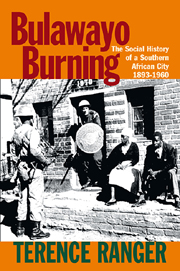Book contents
- Frontmatter
- Contents
- List of Illustrations
- Introduction
- Prelude: Bulawayo, 1893–1930
- 1 The Landscapes of Bulawayo
- 2 The First Fires: December 1929
- 3 City versus State 1930–1946
- 4 Mr Black Bulawayo 1930–1948
- 5 The Feminization of Black Bulawayo 1948–1960
- 6 Black Bulawayo Transformed
- 7 Black Bulawayo Burns 1960
- Postlude: Bulawayo after 1960
- Selected Bibliography
- Index
4 - Mr Black Bulawayo 1930–1948
Published online by Cambridge University Press: 05 April 2013
- Frontmatter
- Contents
- List of Illustrations
- Introduction
- Prelude: Bulawayo, 1893–1930
- 1 The Landscapes of Bulawayo
- 2 The First Fires: December 1929
- 3 City versus State 1930–1946
- 4 Mr Black Bulawayo 1930–1948
- 5 The Feminization of Black Bulawayo 1948–1960
- 6 Black Bulawayo Transformed
- 7 Black Bulawayo Burns 1960
- Postlude: Bulawayo after 1960
- Selected Bibliography
- Index
Summary
A Hero for Black Bulawayo
My narrative of the feud between Bulawayo and the Rhodesian state has brought me to 1946. This is the year in which Yvonne Vera set Butterfly Burning, at a moment, she says in its opening lines, when ‘there is a pause. An expectation’. Her sense of timing was exact. The novel takes place in Makokoba just as a new urban world is struggling to emerge from the old. Yvonne's hero, Fumbatha – who built much of Bulawayo with his strength and sweat – personifies the old. Her heroine, Phephelaphi, personifies the new, feminized, urban culture, with all its possibilities and frustrations. I will seek in a later chapter to lay out Phephelaphi's world. In this one I want to look at Fumbatha's. I want to ask what Bulawayo's Africans were experiencing and doing during those years when city and state fought over their future. And just as I personified that struggle in the figures of Macintyre and Huggins, and just as Yvonne personifies Makokoba in 1946, so I want to narrate the years in Makokoba between 1930 and the late 1940s through the life of one person.
But who to choose? The Reverend Thompson Samkange, one of the heroes of the 1929 faction fights as he sallied out from the Makokoba Methodist Church to succour the wounded, left Bulawayo in the mid-1930s to serve in Mashonaland. Joshua Nkomo, who certainly became Mr Bulawayo and went on to become Father Zimbabwe, was only 29 in 1946, his extraordinary career just beginning.
- Type
- Chapter
- Information
- Bulawayo BurningThe Social History of a Southern African City, 1893–1960, pp. 131 - 166Publisher: Boydell & BrewerPrint publication year: 2010



